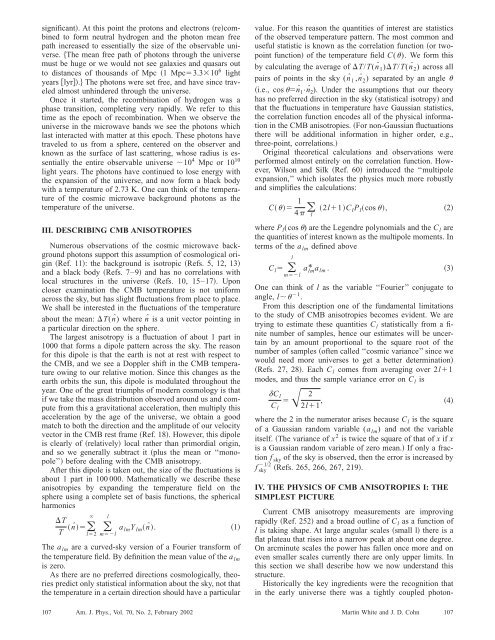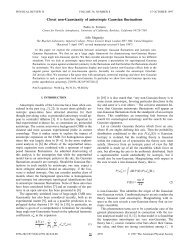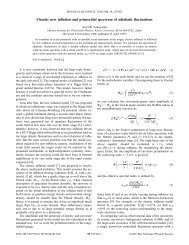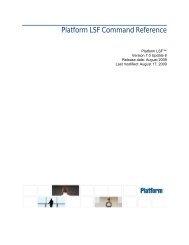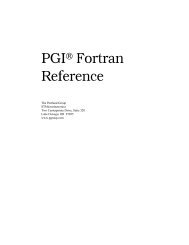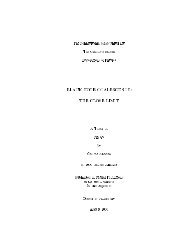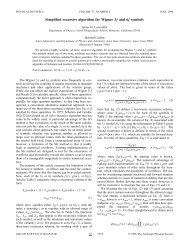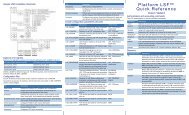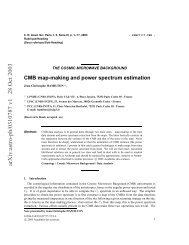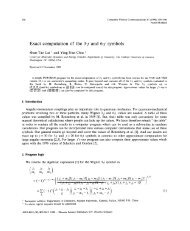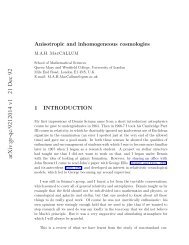Resource Letter: TACMB-1: The theory of anisotropies in the ... - iucaa
Resource Letter: TACMB-1: The theory of anisotropies in the ... - iucaa
Resource Letter: TACMB-1: The theory of anisotropies in the ... - iucaa
You also want an ePaper? Increase the reach of your titles
YUMPU automatically turns print PDFs into web optimized ePapers that Google loves.
significant. At this po<strong>in</strong>t <strong>the</strong> protons and electrons recomb<strong>in</strong>ed<br />
to form neutral hydrogen and <strong>the</strong> photon mean free<br />
path <strong>in</strong>creased to essentially <strong>the</strong> size <strong>of</strong> <strong>the</strong> observable universe.<br />
<strong>The</strong> mean free path <strong>of</strong> photons through <strong>the</strong> universe<br />
must be huge or we would not see galaxies and quasars out<br />
to distances <strong>of</strong> thousands <strong>of</strong> Mpc 1 Mpc3.310 6 light<br />
years lyr. <strong>The</strong> photons were set free, and have s<strong>in</strong>ce traveled<br />
almost unh<strong>in</strong>dered through <strong>the</strong> universe.<br />
Once it started, <strong>the</strong> recomb<strong>in</strong>ation <strong>of</strong> hydrogen was a<br />
phase transition, complet<strong>in</strong>g very rapidly. We refer to this<br />
time as <strong>the</strong> epoch <strong>of</strong> recomb<strong>in</strong>ation. When we observe <strong>the</strong><br />
universe <strong>in</strong> <strong>the</strong> microwave bands we see <strong>the</strong> photons which<br />
last <strong>in</strong>teracted with matter at this epoch. <strong>The</strong>se photons have<br />
traveled to us from a sphere, centered on <strong>the</strong> observer and<br />
known as <strong>the</strong> surface <strong>of</strong> last scatter<strong>in</strong>g, whose radius is essentially<br />
<strong>the</strong> entire observable universe 10 4 Mpc or 10 10<br />
light years. <strong>The</strong> photons have cont<strong>in</strong>ued to lose energy with<br />
<strong>the</strong> expansion <strong>of</strong> <strong>the</strong> universe, and now form a black body<br />
with a temperature <strong>of</strong> 2.73 K. One can th<strong>in</strong>k <strong>of</strong> <strong>the</strong> temperature<br />
<strong>of</strong> <strong>the</strong> cosmic microwave background photons as <strong>the</strong><br />
temperature <strong>of</strong> <strong>the</strong> universe.<br />
III. DESCRIBING CMB ANISOTROPIES<br />
Numerous observations <strong>of</strong> <strong>the</strong> cosmic microwave background<br />
photons support this assumption <strong>of</strong> cosmological orig<strong>in</strong><br />
Ref. 11: <strong>the</strong> background is isotropic Refs. 5, 12, 13<br />
and a black body Refs. 7–9 and has no correlations with<br />
local structures <strong>in</strong> <strong>the</strong> universe Refs. 10, 15–17. Upon<br />
closer exam<strong>in</strong>ation <strong>the</strong> CMB temperature is not uniform<br />
across <strong>the</strong> sky, but has slight fluctuations from place to place.<br />
We shall be <strong>in</strong>terested <strong>in</strong> <strong>the</strong> fluctuations <strong>of</strong> <strong>the</strong> temperature<br />
about <strong>the</strong> mean: T(nˆ ) where nˆ is a unit vector po<strong>in</strong>t<strong>in</strong>g <strong>in</strong><br />
a particular direction on <strong>the</strong> sphere.<br />
<strong>The</strong> largest anisotropy is a fluctuation <strong>of</strong> about 1 part <strong>in</strong><br />
1000 that forms a dipole pattern across <strong>the</strong> sky. <strong>The</strong> reason<br />
for this dipole is that <strong>the</strong> earth is not at rest with respect to<br />
<strong>the</strong> CMB, and we see a Doppler shift <strong>in</strong> <strong>the</strong> CMB temperature<br />
ow<strong>in</strong>g to our relative motion. S<strong>in</strong>ce this changes as <strong>the</strong><br />
earth orbits <strong>the</strong> sun, this dipole is modulated throughout <strong>the</strong><br />
year. One <strong>of</strong> <strong>the</strong> great triumphs <strong>of</strong> modern cosmology is that<br />
if we take <strong>the</strong> mass distribution observed around us and compute<br />
from this a gravitational acceleration, <strong>the</strong>n multiply this<br />
acceleration by <strong>the</strong> age <strong>of</strong> <strong>the</strong> universe, we obta<strong>in</strong> a good<br />
match to both <strong>the</strong> direction and <strong>the</strong> amplitude <strong>of</strong> our velocity<br />
vector <strong>in</strong> <strong>the</strong> CMB rest frame Ref. 18. However, this dipole<br />
is clearly <strong>of</strong> relatively local ra<strong>the</strong>r than primordial orig<strong>in</strong>,<br />
and so we generally subtract it plus <strong>the</strong> mean or ‘‘monopole’’<br />
before deal<strong>in</strong>g with <strong>the</strong> CMB anisotropy.<br />
After this dipole is taken out, <strong>the</strong> size <strong>of</strong> <strong>the</strong> fluctuations is<br />
about 1 part <strong>in</strong> 100 000. Ma<strong>the</strong>matically we describe <strong>the</strong>se<br />
<strong>anisotropies</strong> by expand<strong>in</strong>g <strong>the</strong> temperature field on <strong>the</strong><br />
sphere us<strong>in</strong>g a complete set <strong>of</strong> basis functions, <strong>the</strong> spherical<br />
harmonics<br />
l<br />
T<br />
T nˆ <br />
l2<br />
a lm Y lm nˆ .<br />
1<br />
ml<br />
<strong>The</strong> a lm are a curved-sky version <strong>of</strong> a Fourier transform <strong>of</strong><br />
<strong>the</strong> temperature field. By def<strong>in</strong>ition <strong>the</strong> mean value <strong>of</strong> <strong>the</strong> a lm<br />
is zero.<br />
As <strong>the</strong>re are no preferred directions cosmologically, <strong>the</strong>ories<br />
predict only statistical <strong>in</strong>formation about <strong>the</strong> sky, not that<br />
<strong>the</strong> temperature <strong>in</strong> a certa<strong>in</strong> direction should have a particular<br />
value. For this reason <strong>the</strong> quantities <strong>of</strong> <strong>in</strong>terest are statistics<br />
<strong>of</strong> <strong>the</strong> observed temperature pattern. <strong>The</strong> most common and<br />
useful statistic is known as <strong>the</strong> correlation function or twopo<strong>in</strong>t<br />
function <strong>of</strong> <strong>the</strong> temperature field C(). We form this<br />
by calculat<strong>in</strong>g <strong>the</strong> average <strong>of</strong> T/T(nˆ 1)T/T(nˆ 2) across all<br />
pairs <strong>of</strong> po<strong>in</strong>ts <strong>in</strong> <strong>the</strong> sky (nˆ 1 ,nˆ 2) separated by an angle <br />
i.e., cos nˆ1•nˆ2). Under <strong>the</strong> assumptions that our <strong><strong>the</strong>ory</strong><br />
has no preferred direction <strong>in</strong> <strong>the</strong> sky statistical isotropy and<br />
that <strong>the</strong> fluctuations <strong>in</strong> temperature have Gaussian statistics,<br />
<strong>the</strong> correlation function encodes all <strong>of</strong> <strong>the</strong> physical <strong>in</strong>formation<br />
<strong>in</strong> <strong>the</strong> CMB <strong>anisotropies</strong>. For non-Gaussian fluctuations<br />
<strong>the</strong>re will be additional <strong>in</strong>formation <strong>in</strong> higher order, e.g.,<br />
three-po<strong>in</strong>t, correlations.<br />
Orig<strong>in</strong>al <strong>the</strong>oretical calculations and observations were<br />
performed almost entirely on <strong>the</strong> correlation function. However,<br />
Wilson and Silk Ref. 60 <strong>in</strong>troduced <strong>the</strong> ‘‘multipole<br />
expansion,’’ which isolates <strong>the</strong> physics much more robustly<br />
and simplifies <strong>the</strong> calculations:<br />
C 1<br />
2l1C<br />
4 l P l cos ,<br />
2<br />
l<br />
where P l (cos ) are <strong>the</strong> Legendre polynomials and <strong>the</strong> C l are<br />
<strong>the</strong> quantities <strong>of</strong> <strong>in</strong>terest known as <strong>the</strong> multipole moments. In<br />
terms <strong>of</strong> <strong>the</strong> a lm def<strong>in</strong>ed above<br />
l<br />
C l <br />
ml<br />
a lm<br />
* a lm .<br />
3<br />
One can th<strong>in</strong>k <strong>of</strong> l as <strong>the</strong> variable ‘‘Fourier’’ conjugate to<br />
angle, l 1 .<br />
From this description one <strong>of</strong> <strong>the</strong> fundamental limitations<br />
to <strong>the</strong> study <strong>of</strong> CMB <strong>anisotropies</strong> becomes evident. We are<br />
try<strong>in</strong>g to estimate <strong>the</strong>se quantities C l statistically from a f<strong>in</strong>ite<br />
number <strong>of</strong> samples, hence our estimates will be uncerta<strong>in</strong><br />
by an amount proportional to <strong>the</strong> square root <strong>of</strong> <strong>the</strong><br />
number <strong>of</strong> samples <strong>of</strong>ten called ‘‘cosmic variance’’ s<strong>in</strong>ce we<br />
would need more universes to get a better determ<strong>in</strong>ation<br />
Refs. 27, 28. Each C l comes from averag<strong>in</strong>g over 2l1<br />
modes, and thus <strong>the</strong> sample variance error on C l is<br />
C l<br />
C l<br />
2<br />
2l1 ,<br />
where <strong>the</strong> 2 <strong>in</strong> <strong>the</strong> numerator arises because C l is <strong>the</strong> square<br />
<strong>of</strong> a Gaussian random variable (a lm ) and not <strong>the</strong> variable<br />
itself. <strong>The</strong> variance <strong>of</strong> x 2 is twice <strong>the</strong> square <strong>of</strong> that <strong>of</strong> x if x<br />
is a Gaussian random variable <strong>of</strong> zero mean. If only a fraction<br />
f sky <strong>of</strong> <strong>the</strong> sky is observed, <strong>the</strong>n <strong>the</strong> error is <strong>in</strong>creased by<br />
f 1/2 sky Refs. 265, 266, 267, 219.<br />
IV. THE PHYSICS OF CMB ANISOTROPIES I: THE<br />
SIMPLEST PICTURE<br />
Current CMB anisotropy measurements are improv<strong>in</strong>g<br />
rapidly Ref. 252 and a broad outl<strong>in</strong>e <strong>of</strong> C l as a function <strong>of</strong><br />
l is tak<strong>in</strong>g shape. At large angular scales small l <strong>the</strong>re is a<br />
flat plateau that rises <strong>in</strong>to a narrow peak at about one degree.<br />
On arcm<strong>in</strong>ute scales <strong>the</strong> power has fallen once more and on<br />
even smaller scales currently <strong>the</strong>re are only upper limits. In<br />
this section we shall describe how we now understand this<br />
structure.<br />
Historically <strong>the</strong> key <strong>in</strong>gredients were <strong>the</strong> recognition that<br />
<strong>in</strong> <strong>the</strong> early universe <strong>the</strong>re was a tightly coupled photon-<br />
4<br />
107 Am. J. Phys., Vol. 70, No. 2, February 2002<br />
Mart<strong>in</strong> White and J. D. Cohn 107


